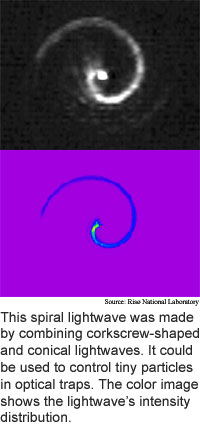
Spiral laser beam demoed
Researchers have for years used light to
move and manipulate tiny particles; the energy in a light beam affects
particles like cells in the same way wind affects larger objects.
Researchers from the University of the Philippines and Risų National
Laboratory in Denmark have found a way to generate helico-conical, or
spiral-shaped light beams. The unusual-shaped beams are potentially useful
in trapping and manipulating particles in biological and medical devices,
including biochips.
The researchers generated the spiral light beams using a liquid
crystal spatial light modulator, which is like a liquid crystal display
that shapes laser beams passing through it. The researchers merged corkscrew-
and cone-shaped lightwaves to produce the spiral beam. Corkscrew lightwaves
have a ring-shaped cross-section; the researchers' beams have a spiral
cross-section.
The next steps are implementing the spiral beam in a high-power
optical trap to test the way the beam interacts with microparticles. The
technique could be used to rotate asymmetrical particles and to sweep
small particles toward the beam's focal point. The researchers are also
working to more fully understand the dynamics of the spiral beams.
The spiral lightwaves could be used practically within a year,
according to the researchers. The work appeared in the March 7, 2005 issue
of Optics Express (Helico-Conical Optical Beams: a Product of Helical
and Conical Phase Fronts).
Stories:
Telescopes make bug-eye optics
Summarizer ranks sentences
Impact Assessment:
Overly smart buildings
Briefs:
Ultraviolet shifts plastic's shape
Spiral laser beam demoed
Nanotube chemical sensor gains speed
Trapped cells make micromotors

Research Watch blog
View from the High Ground Q&A
How It Works
RSS Feeds:
News
Ad links:
Buy an ad link
Ad links: Clear History
Buy an ad link
|
TRN
Newswire and Headline Feeds for Web sites
|
© Copyright Technology Research News, LLC 2000-2010. All rights reserved.